This Is How Potted Meat Is Really Made
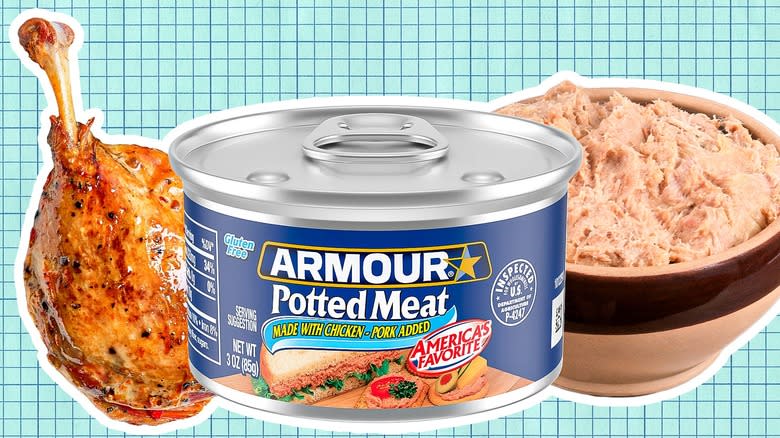
Potted meat has dedicated fans and dedicated haters, with advocates loving the convenience and ease of the meat's preparation because all you have to do is open a can. Haters can't stand the texture or taste, or they possess bad memories of having to subsist off the stuff as kids. But it's worth noting that the commercially available potted meat that lives in cans in your pantry is not the same as traditional potted meat, which you can make at home.
Homemade traditional potted meat has helped people preserve meat for centuries. Back before the invention of refrigeration, potting meat allowed people to keep this protein in a non-dried form as long as they could store it in a relatively cold place. The process of making it is actually pretty simple, if time-consuming. It's clearly different from the process for making commercially available potted meat, which has gained a reputation as a mystery meat. However, while it's true that there is a little mystery involved regarding the parts used to make the meat paste, most of the ingredients and details of the process are straightforward. Here's how potted meat is really made.
Read more: 16 Little-Known Facts About Salt
Traditional Potted Meat Differs From Commercially Made Potted Meat
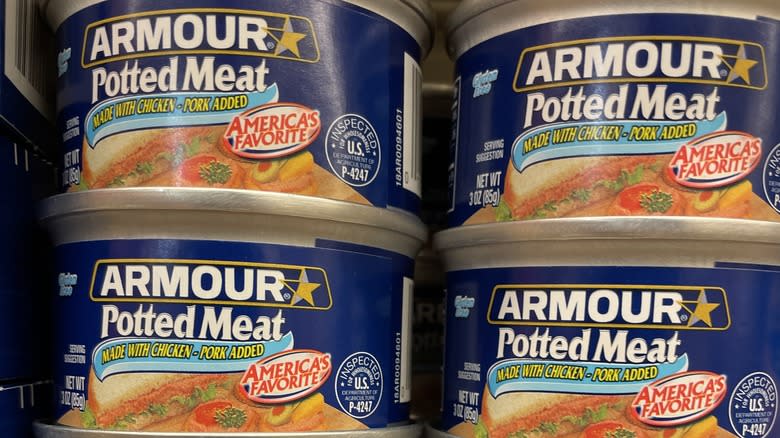
Potted meat, in its most traditional form, is meat that's been cooked in broth or fat, ground into a paste, packed into containers, and then covered with a layer of some sort of fat. The fat layer is supposed to completely seal in the meat with no access to air and is meant to prevent bacteria from reaching the meat and spoiling it. The meat can be seasoned and is usually salted. Sometimes sodium nitrite is added to help with preservation.
Modern, commercially made potted meat generally does not have a fat layer. Instead, the meat is cooked, seasoned, ground up, and packed into cans. Potted meat made for sale in grocery stores is shelf-stable until opened. After that point, the meat has to be refrigerated. Traditional potted meat has to be kept cold, too, but older forms of storage (such as a cold larder) are not considered adequate now.
Homemade Potted Meat Has To Stay Cold

Commercial potted meat may generally be shelf-stable, but that's because it goes through commercial canning processes that treat the contents like any other canned meat and preserve it. Homemade potted meat is not shelf-stable at all. In fact, the traditional procedure of covering the cooked meat with an impermeable layer of fat and then storing it in a cold place is no longer considered a safe practice.
You can certainly make potted meat using a traditional recipe and method. But once you seal the meat into the container with the layer of fat, you must refrigerate the potted meat. It's too easy to leave behind some water and a tiny gap in the fat layer that could lead to mold growth, not to mention the risk of bacteria or other pathogens getting inside the container. Refrigeration is essential for safe homemade potted meat no matter how good you may be at preserving food.
Think of homemade potted meat as a way to extend your supply of protein over a few weeks at most, rather than a long-term preservation method. If you were hoping to include potted meat in your emergency food storage, stick with commercially available products instead.
The Meat Is Usually Ground Into A Paste (But Not Always)
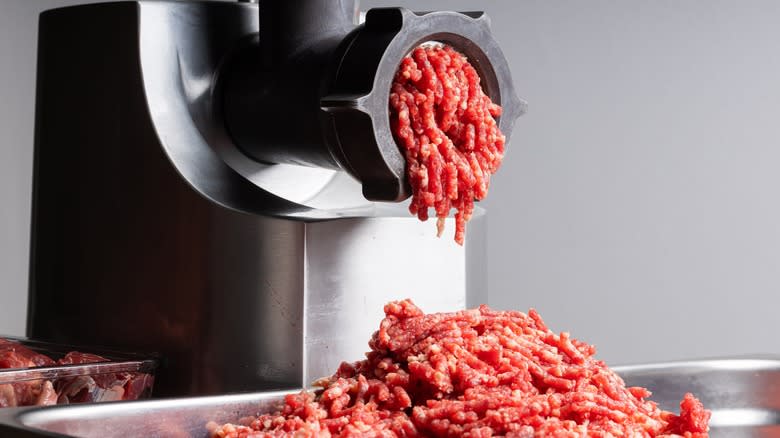
Commercially made potted meat is a paste that you can spread on crackers or bread. In most recipes, you're supposed to grind up the meat you cook into a similar paste. This not only helps with spreading but also makes it easier to pack the food in the can or other vessel without leaving any gaps that would waste space and invite pathogens in.
You can use two more methods to turn the meat into a paste if you don't have a meat grinder. One option is to blend the meat, which is fast but messy to clean up. You may have to spend more time than you planned cleaning out the blender to ensure there's no meat debris left behind to fester. (Like peanut butter, raw meat can get stuck in all the little grooves inside the blender jar.)
The other method is to pound the cooked meat, such as with a mortar and pestle. That option would take a long time if you're trying to make a large quantity of potted meat. And again, meat can get caught in any little grooves, indentations, or other features of your vessel. In other words, you'll have to clean the mortar and pestle very carefully.
Potted Meat Is Typically Slow-Cooked
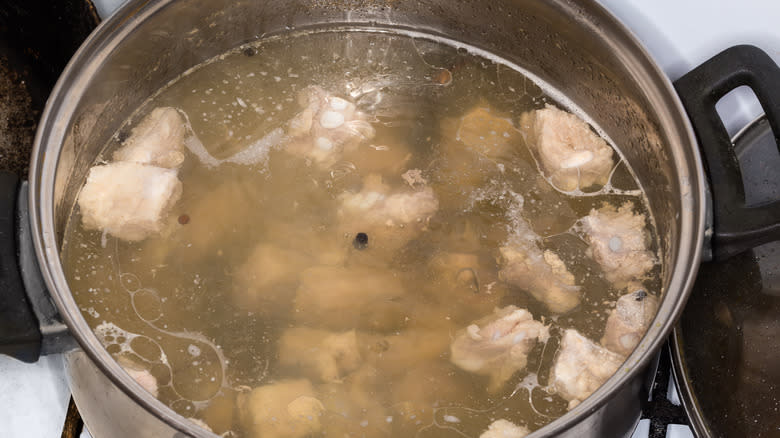
Slow cooking refers to two types of cooking. One is cooking something in an actual slow cooker, such as the name-brand Crock-Pot. The other means cooking food for a very long time at a low temperature, even if it's in a more standard pot and not in a slow cooker. Whatever the vessel, slow cooking allows food to become tender while sitting in a hot environment for a long time. Faster cooking at a higher temperature could unevenly cook the food and make it tough, neither of which is good for preservation.
Not all potted meat recipes rely on slow cookers, but even stovetop instructions say you need to cook for a couple of hours at a minimum. Some recipes even have you cook the meat, turn it into a paste, and then bake the result for a while longer before putting the paste into the storage container. If you set out to make homemade potted meat, be prepared to take a while. You're best off treating it like a weekend project, at least until you get the hang of it.
It's High In Salt For A Reason
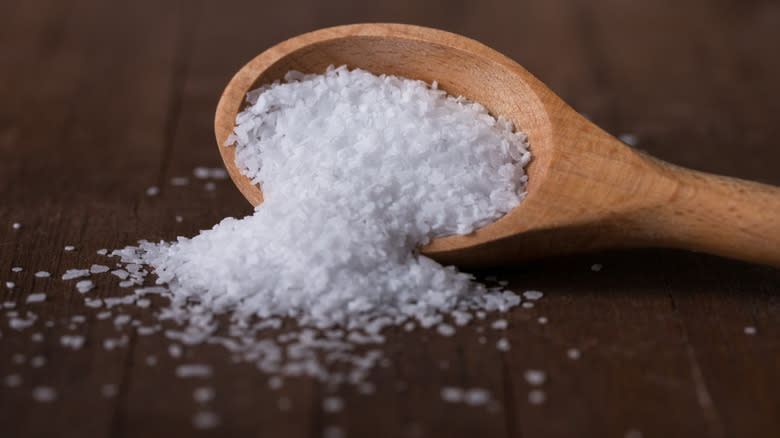
Potted meat is salty. Really salty. Reviews often mention how salty most types are. If you're trying to avoid excess sodium in your diet, then the truth is that you ought to avoid potted meat. If you eat too much salt, that can raise blood pressure and lead to other conditions. However, while controlling sodium is a good goal for many people, sometimes high sodium levels are necessary in certain foods.
Potted meat is typically high in sodium because salt is a preservative. The salt, cold storage, layer of fat, and intense cooking process all work together to keep the meat safe to eat. One alone may not be enough, but put them all together and you'll likely have a pretty good team working to control bacterial growth. So while the salt level may mean you'll want to reduce how much potted meat you eat, realize that it's not there solely to add flavor. Instead, it's a necessary preservative. Eating the potted meat with something that isn't salty can help mellow out the taste.
Botulism Can Be A Problem In Homemade Recipes

Homemade potted meat sounds like it could be an interesting project for the budding home food scientist, but be careful. Botulism is a particular problem in homemade recipes, and you have to process the meat very carefully to eliminate as much of the risk as possible. If food isn't canned properly, bacteria can get inside the can and grow, including the organism that causes botulism. What's more, botulism doesn't need oxygen to thrive. It also loves low-acid environments, such as what's often found in canned meat.
While adding sodium nitrite can help preserve the food, you still have to prepare and store it correctly. Once the meat has been cooked and sealed into the container with a layer of fat, you need to keep the potted meat in a refrigerator. Keeping the food under 40 degrees Fahrenheit is essential for preventing the growth of the bacteria that causes botulism.
The meat should also be properly salted and the entire container should be used up within a short time. This is last point is a very good reason to use small containers when making potted meat at home. Don't try to keep homemade potted meat in the pantry, even if the pantry is relatively cold. Chances are it won't be consistently cold enough to mimic consistent refrigeration.
Modern Potted Meat Is Usually A Combination Of Meats
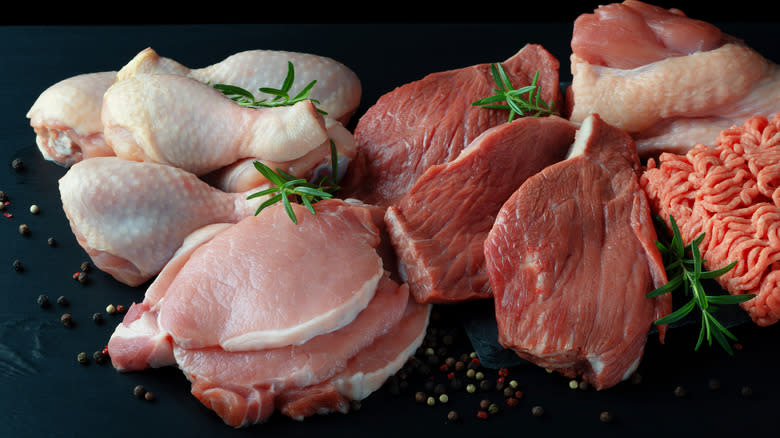
When potted meat was made at home, way back when, each container usually had one type of meat inside. The meat used was from parts of the animal that people recognized and would eat without hesitation. But now, the purpose of potted meat isn't to preserve the meat you've stored up for the winter, but to have cheap, shelf-stable food that offers protein and convenience. Because potted meat often contains cuts that aren't exactly tempting (more on that in a minute), taste becomes an issue.
Today, commercial potted meat is usually a combination of meats, such as chicken and pork or chicken and beef. Combining meats often helps one meat taste better while offering a more filling food. For example, take the combination of chicken and pork. Either on its own tastes fine, but when you combine them, you get the fat of the pork helping keep the mixture moist, while chicken provides a lower-fat source of protein. The resulting combination means the mixture isn't completely fatty, but it isn't too dry, either.
Whether potted meat manufacturers developed combinations for this reason is unknown, but it makes sense that manufacturers would want to enhance the flavor of the meat as much as possible. It also helps that the meats used tend to be on the cheaper side.
Commercial Potted Meat Could Be From Many Parts Of The Animal
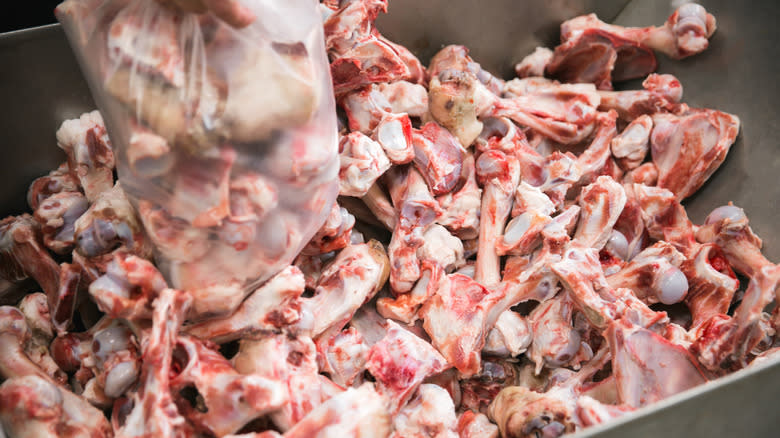
If you are not a fan of eating what many consider to be unconventional cuts of meat, you might not like commercially available potted meat. That's because it uses seemingly any part of the animal that was available during processing. And it is not always obvious which parts of the animals the meat came from.
There are many who insist potted meat is from some really unwanted and downright unsavory parts of the animals, but the meat is from whatever parts are available to the manufacturers and legally okay for consumption. This can include stomachs, nerves, and fatty tissue. If you're not a fan of consuming mechanically separated meat that could be from any cut, potted meat may not be your thing. But if you're okay with that origin as long as the meat was cooked and canned properly, commercially canned potted meat can be a helpful food to keep around your home for the long term.
Potted Meat Is Not The Same As SPAM Or Deviled Spreads
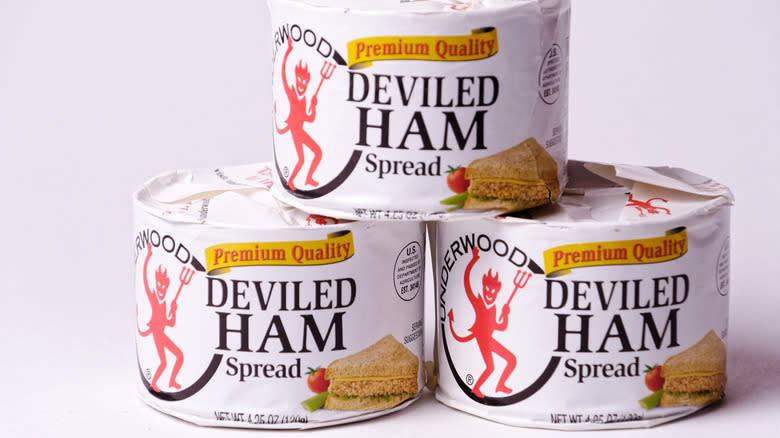
Spreadable meat in a can sounds a lot like a couple of other preserved meat products, and those consumers who are unfamiliar with potted meat often think all three products are basically the same. One product that people often think of is SPAM, which isn't spreadable. You more typically slice and bake or fry SPAM, though there's no doubt that, if you tried hard enough, you could mash it into something that looked like a paste. But SPAM is a solid meat product that isn't created in the same way as spreadable potted meat.
Another product is close to, but still not the same as, potted meat. This is deviled meat, usually available as deviled ham or deviled chicken. You may have seen cans of these wrapped in paper from the Underwood company at your grocery store. "Deviled" is a culinary term that refers to the addition of hot seasonings like mustard or cayenne pepper to. For example, deviled eggs may contain Dijon mustard or paprika, which can be spicy. Deviled ham and chicken look like potted meat and are spreadable meats that you can eat straight from the can. But they're not slow-cooked and then covered in fat. Instead, in this preparation, ground meat is mixed with spices and other seasonings to created a flavored sandwich spread.
Commercial Potted Meat Is Supposed To Be Ready To Eat Out Of The Container
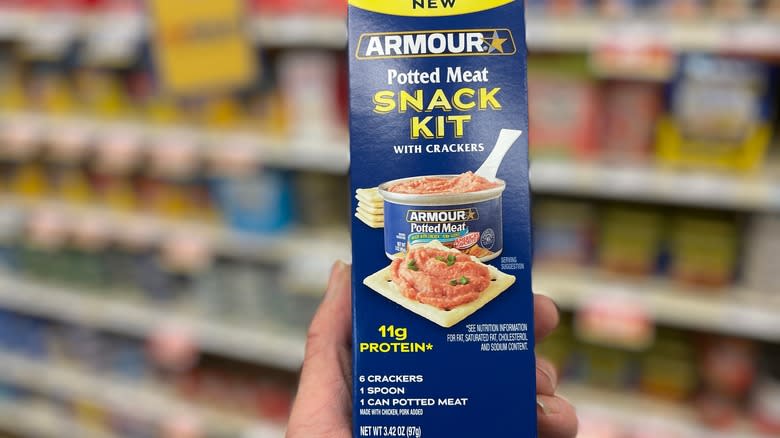
Commercial potted meat that you buy at the store is meant to be ready to eat out of the container. As in, you can conceivably spoon it right out of the can and into your mouth, with no need to warm it up. Eating canned potted meat spread on crackers with no other preparation was and is still common, after all. But that wasn't always the case back when refrigerators weren't common.
Any meat that's potted is technically cooked. That's part of the preparation process, in which meat is cooked for hours before it's put into a container and sealed in with fat. But way back when food was kept cold in cellars and not refrigerators, longer storage could be problematic. That's because it wasn't always easy to keep the cold storage area at a consistent temperature, especially in warmer seasons.
Because of this, potted meats that had been stored for a long time were often cooked again before serving, unless the meats had been preserved only a week or two before and the weather was very cold anyway. By the way, if you're making potted meat at home, never try to keep it in a cool but non-refrigerated area for even a couple of days. Once it's been sealed in its jar, take advantage of modern food safety and place it in the refrigerator.
Rillettes, Duck Confit, And Potted Meat Are Related
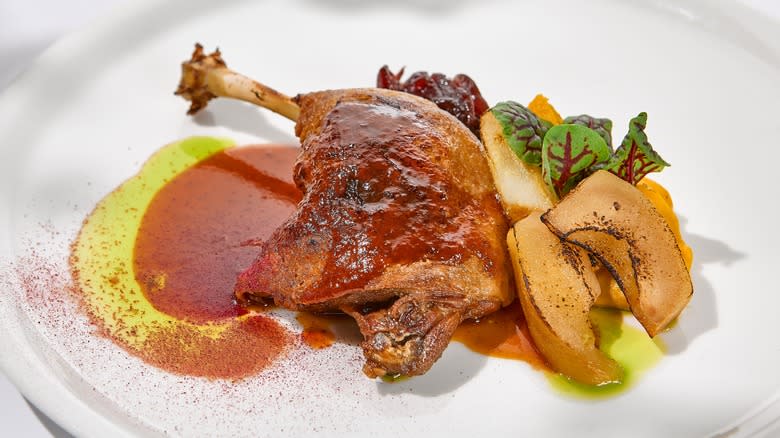
Potted meat may sound very odd if you've never had it before, but it's related to two other foods that are more common and, in fact, are arguably seen as kind of gourmet. One is rillettes, and the other is duck confit. Meat confit is meat that's cooked very slowly while it's submerged in fat. It can be preserved in a jar for about a month if the meat is then fully submerged in the fat and the final product is kept in the refrigerator (though always discard if you're unsure about its quality). Duck confit is a common confit dish and is often treated as special, when in reality it's just a tasty way of preparing and potting duck meat while it's still on the bone.
Rillettes are also slow-cooked and prepared as potted meats, usually using pork. They're seasoned with herbs and often found on the menus of gourmet restaurants. Rillettes are part of classic French and Mediterranean cuisine and can command a pretty price when eating out. It's similar to pate but with a texture that's chunkier. And, as always, it's smart to refrigerate either variety.
Watch Out If You Need Gluten-Free Potted Meat
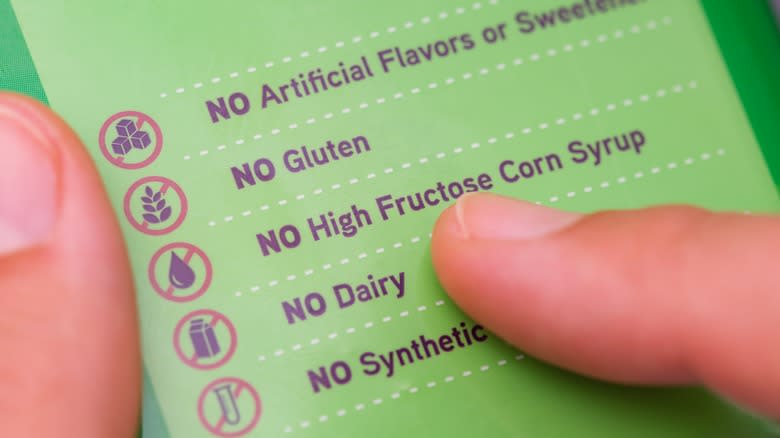
Potted meat usually doesn't contain wheat or similar gluten-rich ingredients outright, but many brands use natural flavors as part of a recipe. These are flavoring agents derived from natural sources like plants and used to amp up the flavor of the meat. Sometimes the natural flavors are derived from wheat, and in the U.S., if the food is regulated by the FDA, the product label has to state that the product contains wheat. But other times, the natural flavors are derived from gluten-containing sources like barley, which may not necessarily be something the FDA requires manufacturers to include on the label if it's just the source of the natural-flavor additive.
For people who can't have gluten, this is obviously a problem. Foods that are certified gluten-free and that list natural flavors in the ingredients are likely okay. But otherwise, you have to figure out what brands you can trust. Some brands may list the sources of natural flavors on websites or state that products are gluten-free, while others leave them a secret. You can also check other sources to find where a company gets its natural flavors. Generally speaking, anyone who needs to avoid gluten should be careful with unfamiliar products.
Read the original article on Mashed.


